Bihar BEd CET 2020 Set C Question paper with answer key pdf conducted on September 22, 2020 is available for download. The exam was successfully organized by Lalit Narayan Mithila University. The question paper comprised a total of 120 questions.
Bihar BEd CET 2020 Set C Question Paper with Answer Key PDFs
| Bihar BEd 2020 Set C Question Paper with Answer Key | Download PDF | Check Solution |

Question 1:
Work hard ____ you should fail.
View Solution
The sentence implies a condition or consequence, so “or” fits correctly: “Work hard or you should fail.”
Quick Tip: Use “or” when indicating negative consequences in conditional structures.
At last he yielded ___ the temptation.
View Solution
The correct preposition after “yielded” in this context is “to”.
Quick Tip: "Yield to temptation" is a common collocation in English.
We sailed ___ the river.
View Solution
The phrase “sailed down the river” is idiomatic and indicates movement along the river.
Quick Tip: Use “down” with rivers to indicate direction of flow.
One should not make ‘irrelevant’ remarks:
View Solution
“Irrelevant” means not related to the subject, hence “not being to the point.”
Quick Tip: Irrelevant = not connected or not appropriate to the matter at hand.
We must 'give up' our bad habits:
View Solution
To “give up” means to stop doing something, especially a habit – here “leave” fits best.
Quick Tip: “Give up” is a phrasal verb meaning to quit or stop.
Sardar Patel was ‘iron man’:
View Solution
“Iron man” refers to someone strong and determined.
Quick Tip: Sardar Patel is famously called “The Iron Man of India” for his firmness.
The boy was 'knocked down' by a truck:
View Solution
“Knocked down” means being hit and brought to the ground, commonly used with vehicles.
Quick Tip: "Knocked down" by a vehicle = struck and often seriously injured.
To read between the lines:
View Solution
"To read between the lines" means to perceive or understand a meaning that is not directly stated but implied. It refers to grasping the hidden or underlying meaning of something, especially in writing or speech.
Quick Tip: Always consider context clues and subtle hints in a passage to "read between the lines."
The soldier was ‘Kind’: (Find the opposite)
View Solution
The opposite of “kind” is “cruel” which means deliberately causing pain.
Quick Tip: Kind vs. Cruel – antonym relationship.
The teacher was ‘happy’ with the student: (Find the opposite)
View Solution
“Happy” is an emotional state of joy, and the opposite is “sad”.
Quick Tip: Happy and sad are basic emotional opposites.
Animals that feed on grass:
View Solution
Herbivorous animals feed on plants or grass.
Quick Tip: Herbivores feed primarily on plants and grasses, such as cows and deer.
Animals that can live on land and water:
View Solution
Amphibious animals can live both on land and in water. Examples include frogs and turtles.
Quick Tip: Amphibians are species that can thrive in both aquatic and terrestrial environments.
Custom of having many wives:
View Solution
Polygamy refers to the practice of having more than one spouse simultaneously.
Quick Tip: Polygamy involves multiple spouses, while monogamy involves only one spouse at a time.
A thing which easily catches fire:
View Solution
Inflammable materials easily catch fire, unlike nonflammable materials which do not.
Quick Tip: Inflammable means easily ignitable; be careful with materials labeled as such.
An unmarried man:
View Solution
A bachelor is an unmarried man.
Quick Tip: A bachelor refers to a man who is not married, unlike a widower or divorced man.
इन्हें से महाप्राण ध्वनि चुनें।
View Solution
"क" शब्द का उच्चारण करते समय अधिक बल दिया जाता है। इसे महाप्राण ध्वनि के रूप में जाना जाता है।
Quick Tip: महाप्राण ध्वनियों में 'क', 'ख', 'ग' जैसे शब्द आते हैं, जो अधिक बल से उच्चारित होते हैं।
दिए गए रित स्थान पर उचित चिन्ह चुनें:
"अह....कितना सुन्दर पुनः फलित है।"
View Solution
यहाँ विस्मयादिबोधक चिह्न '!' का प्रयोग किया गया है, क्योंकि वाक्य में कोई विस्मय, अप्रत्याशित भावना व्यक्त की जा रही है।
Quick Tip: जब वाक्य में विस्मय या उत्तेजना व्यक्त की जाती है, तो '!' का उपयोग करें।
इन्हें ‘अल्पविराम’ चिह्न को पहचानें।
View Solution
अल्पविराम (,) का प्रयोग वाक्य के विभिन्न हिस्सों को जोड़ने के लिए किया जाता है।
Quick Tip: वाक्य में विभिन्न भागों को जोड़ने के लिए ‘,’ का उपयोग करें।
चौपाई के प्रारंभिक चरण में कितनी मात्रा होती है?
View Solution
चौपाई मीटर में प्रत्येक पंक्ति में 16 मात्राएँ होती हैं।
Quick Tip: चौपाई मीटर हिंदी काव्य का एक सामान्य मीटर है जिसमें 16 मात्राएँ होती हैं।
‘रामचरितमानस’ की रचना शैली क्या है?
View Solution
‘रामचरितमानस’ दोहा-चौपाई मीटर में लिखा गया है।
Quick Tip: ‘रामचरितमानस’ में दोहा-चौपाई मीटर का प्रयोग किया गया है, जो हिंदी काव्य की पारंपरिक शैली है।
‘संस्कार’ शब्द में किस उपसर्ग का प्रयोग हुआ है?
View Solution
‘संस्कार’ शब्द में सम् उपसर्ग का प्रयोग हुआ है, जो किसी कार्य या स्थिति के परिपूर्णता या सुधार को दर्शाता है।
Quick Tip: ‘सम्’ उपसर्ग का प्रयोग किसी भी शब्द को पूर्णता या उपयुक्तता दर्शाने के लिए होता है।
इन्हें कौन-सा तद्भव शब्द है?
View Solution
‘चतुर्थ’ शब्द संस्कृत के ‘चतुर्थ’ से आया है और यह तद्भव शब्द है।
Quick Tip: तद्भव शब्द वे होते हैं जो संस्कृत से अपभ्रंश रूप में प्रयोग किए जाते हैं।
निर्णलिखित विकल्प में से तद्रव्य शब्द को चुनें।
View Solution
‘हँसी’ शब्द एक तद्रव्य शब्द है, क्योंकि यह शब्द सीधे भारतीय संस्कृति से जुड़ा हुआ है।
Quick Tip: तद्रव्य शब्द उन शब्दों को कहा जाता है जो भारतीय समाज से सीधे जुड़े होते हैं।
इन्हें मूर्धन्य व्यंजन कौन है?
View Solution
‘ग़’ एक मूर्धन्य व्यंजन है जो ह़्रस्व शिरोव्यंजन का हिस्सा है।
Quick Tip: मूर्धन्य व्यंजन वे होते हैं जिनका उच्चारण जीभ को तालु के पास करना होता है।
निम्न में किस शब्द में ‘आ’ उपसर्ग नहीं है?
View Solution
‘आक्रपक’ शब्द में ‘आ’ उपसर्ग नहीं होता है।
Quick Tip: ‘आ’ उपसर्ग का प्रयोग अधिकतर क्रियाओं के साथ होता है जो किसी कार्य की शरुआत को दर्शाते हैं।
निर्णलिखित में किस शब्द में उपसर्ग है?
View Solution
‘दशक’ शब्द में उपसर्ग ‘द’ है। यह किसी व्यक्ति या समय को दर्शाने के लिए प्रयोग किया जाता है।
Quick Tip: उपसर्ग का प्रयोग किसी भी शब्द के अर्थ में बदलाव लाने के लिए किया जाता है।
‘अपने हाथ से स्वयं काम करो’ वाक्य का शुद्ध रूप चुनें।
View Solution
‘अपने हाथ से स्वयं काम करो’ वाक्य का शुद्ध रूप ‘अपना काम स्वयं करो’ है। यह वाक्य शुद्ध हिंदी में है।
Quick Tip: वाक्य में शुद्धता बनाए रखने के लिए हमेशा उचित वाक्य संरचना का पालन करें।
बहुवचन में ‘चिड़िया’ शब्द क्या होता है?
View Solution
"चिड़िया" शब्द का सही बहुवचन "चिड़ियों" होता है। यह पुल्लिंग नहीं, स्त्रीलिंग शब्द है।
Quick Tip: स्त्रीलिंग शब्दों के बहुवचन में अक्सर 'यों' की संधि जुड़ती है।
भाषा की सबसे छोटी इकाई क्या है?
View Solution
भाषा की सबसे छोटी इकाई वर्ण होती है। यह शब्दों के निर्माण का आधार होती है।
Quick Tip: वर्ण ही शब्दों का निर्माण करते हैं, और यह भाषा की सबसे छोटी इकाई होती है।
दारा का अर्थ क्या है?
View Solution
‘दारा’ शब्द का अर्थ पिता होता है। यह एक पारंपरिक शब्द है जो घर के मुखिया को संदर्भित करता है।
Quick Tip: पारंपरिक शब्दों के अर्थ को समझना भाषा के अध्ययन में सहायक होता है।
The train for Patna leaves every two and a half hours from New Delhi Railway Station. An announcement was made at the station that the train for Patna had left 40 minutes ago and the next train will leave 18.00 hrs. At what time was the announcement made?
View Solution
The train leaves every two and a half hours, which means the intervals are 2 hours and 30 minutes. Since the next train leaves at 18.00 hrs, the train that left 40 minutes ago would have departed at 17.20 hrs. Therefore, the announcement was made at 16.10 hrs, which is 40 minutes before the 17.20 hrs departure.
Quick Tip: To calculate the time of an event based on a set interval, subtract the given time from the next scheduled time.
In a class of 60, where boys are twice that of girls, Reena ranked seventeenth from the top. If there are 9 boys ahead of Reena, how many girls are after her in rank?
View Solution
In a class of 60, if boys are twice the number of girls, then there are 40 boys and 20 girls. Reena is 17th from the top, and there are 9 boys ahead of her. Hence, there are 8 girls ahead of her. Since there are 20 girls in total, the number of girls after Reena is 20 - 8 - 1 = 13.
Quick Tip: In rank-related problems, subtract the known number of boys or girls from the total to find the remaining number.
Statement: Sick people need medicine.
Conclusions:
I. Healthy people do not need medicine.
II. People keep medicine in their home.
View Solution
Conclusion I does not follow because the statement does not imply that healthy people do not need medicine; it only mentions sick people need it.
Conclusion II does not follow because keeping medicine at home is not a necessary condition mentioned in the statement.
\begin{quicktipbox
In logical reasoning, always evaluate whether the conclusions are directly supported or implied by the given statement.
\end{quicktipbox Quick Tip: In logical reasoning, always evaluate whether the conclusions are directly supported or implied by the given statement.
Statement: The increasing population of our nation will lead to depletion of many essential resources.
Conclusions:
I. Population of our nation can be controlled.
II. The nation will not be able to provide a decent living to its citizens.
View Solution
Conclusion I does not follow because the statement does not mention anything about controlling the population; it only states the consequence of increasing population.
Conclusion II follows because the depletion of resources, as mentioned, may lead to the inability of the nation to provide a decent living to its citizens.
\begin{quicktipbox
Focus on whether the conclusions are directly linked to the implications of the statement, rather than introducing new information.
\end{quicktipbox Quick Tip: Focus on whether the conclusions are directly linked to the implications of the statement, rather than introducing new information.
Statement: School uniform is a burden on the poor parents.
Courses of Action:
(1) Poor parents should stop buying school uniform.
(2) Schools can provide subsidy on school uniforms.
\textbf{Solution:}
Both courses of action are valid. Poor parents might benefit from not purchasing uniforms, and schools can help alleviate the burden by providing subsidies for uniforms. Hence, both I and II logically follow.
View Solution
Both courses of action are valid. Poor parents might benefit from not purchasing uniforms, and schools can help alleviate the burden by providing subsidies for uniforms. Hence, both I and II logically follow.
Quick Tip: When tackling logical reasoning questions, consider if both actions can work together in addressing the issue.
Statement: School dropout rate is very high in the rural areas as children support their parents in income-earning activities.
Courses of Action:
(1) Public Awareness programme on primary education should be expanded immediately to educate parents.
(2) Compensation is not a remedy.
\textbf{Solution:}
The issue of high dropout rates can be addressed by expanding public awareness programmes to educate parents about the importance of education. Compensation is not a solution to this problem. Thus, only I logically follows.
View Solution
The issue of high dropout rates can be addressed by expanding public awareness programmes to educate parents about the importance of education. Compensation is not a solution to this problem. Thus, only I logically follows.
Quick Tip: When considering courses of action, focus on preventive measures and education over temporary solutions like compensation.
Statement: It is desirable to put the child in school at the age of 5 or so.
Assumptions:
(1) At that age the child reaches appropriate level of development and is ready to learn.
(2) The school does not admit children after six years of age.
\textbf{Solution:}
The statement suggests that putting a child in school at age 5 is desirable because the child is expected to have reached the appropriate level of development. This assumption is implicit, while the statement does not imply that schools do not admit children after six years. Thus, only assumption I is implicit.
View Solution
The statement suggests that putting a child in school at age 5 is desirable because the child is expected to have reached the appropriate level of development. This assumption is implicit, while the statement does not imply that schools do not admit children after six years. Thus, only assumption I is implicit.
Quick Tip: Always identify assumptions that directly support the statement rather than introducing new information.
Statement: A warning in a train compartment - "To stop train, pull chain. Penalty for improper use Rs. 500."
Assumptions:
(1) Some people misuse the alarm chain.
(2) On certain occasions, people may want to stop a running train.
\textbf{Solution:}
The warning implies that people misuse the alarm chain, which supports assumption I. The statement also provides a penalty, which suggests that people may pull the chain under certain circumstances, thus supporting assumption II. Therefore, both assumptions I and II are implicit.
View Solution
The warning implies that people misuse the alarm chain, which supports assumption I. The statement also provides a penalty, which suggests that people may pull the chain under certain circumstances, thus supporting assumption II. Therefore, both assumptions I and II are implicit.
Quick Tip: When determining implicit assumptions, consider whether the provided information suggests a possible cause and effect scenario.
Who was second to Vijay's right?
\textbf{Solution:}
Based on the given information, Neeraj is second to Vijay's right.
View Solution
Based on the given information, Neeraj is second to Vijay's right.
Quick Tip: When solving circular arrangement problems, visualize the seating arrangement to track positions.
Who was between the Neeraj and Vijay?
\textbf{Solution:}
Sudhir is seated between Neeraj and Vijay in the circular arrangement.
View Solution
Sudhir is seated between Neeraj and Vijay in the circular arrangement.
Quick Tip: Focus on the given positions and relationships in circular arrangement questions to find the correct answer.
Who was second to Amar's right?
\textbf{Solution:}
Neeraj is second to Amar's right in the seating arrangement.
View Solution
Neeraj is second to Amar's right in the seating arrangement.
Quick Tip: Use the process of elimination by carefully checking the positions in circular seating arrangements.
Who was between Vijay and Amar?
\textbf{Solution:}
Rakesh and Saurabh both can be seated between Vijay and Amar in this circular arrangement.
View Solution
Rakesh and Saurabh both can be seated between Vijay and Amar in this circular arrangement.
Quick Tip: In circular arrangements, more than one answer might be possible, so check for all viable seating possibilities.
PDJ, UEE, YGA, ......?......, DNV
\textbf{Solution:}
The series follows a pattern in the positions of letters and the order in which they progress, with the missing term being "BXJ."
View Solution
The series follows a pattern in the positions of letters and the order in which they progress, with the missing term being "BXJ."
Quick Tip: In letter series, pay attention to the position of each letter and its progression in the alphabet.
KLZ, ......?......, QPX, TRW, WTV
\textbf{Solution:}
The correct pattern involves consistent increments and placement in the sequence of letters. "MNY" fits the missing term.
View Solution
The correct pattern involves consistent increments and placement in the sequence of letters. "MNY" fits the missing term.
Quick Tip: Carefully examine the changes in the letters from one term to the next to identify the pattern.
ZA, VE, RI, ......?......
\textbf{Solution:}
The pattern is based on the alphabetical progression in the first and second letters. "NM" is the missing term.
View Solution
The pattern is based on the alphabetical progression in the first and second letters. "NM" is the missing term.
Quick Tip: For letter series, check both individual letter shifts and their positions in the alphabet.
......?......, ETCIM, MIETC, CTMIE
\textbf{Solution:}
The series is a simple rearrangement of letters, and "ECTIM" is the missing term that fits the pattern.
View Solution
The series is a simple rearrangement of letters, and "ECTIM" is the missing term that fits the pattern.
Quick Tip: In word or letter series, focus on letter rearrangement and shifts.
(A): The prices of fruits have dropped substantially during the last few days.
(B): The prices of foodgrains have increased substantially during the last few days.
\textbf{Solution:}
Both the drop in fruit prices and the rise in foodgrain prices could be the effects of some common cause, such as economic conditions or market changes.
View Solution
Both the drop in fruit prices and the rise in foodgrain prices could be the effects of some common cause, such as economic conditions or market changes.
Quick Tip: When analyzing cause-effect relationships, consider external factors that could influence both events.
Who is the master of Current Events?
\textbf{Solution:}
Based on the information, the master of current events is C.
View Solution
Based on the information, the master of current events is C.
Quick Tip: Pay attention to relationships such as "unmarried ladies" and "husband" to deduce positions and specialties in such questions.
Who is the master of Sports?
\textbf{Solution:}
The master of sports is A, as none of the ladies hold command over current events or sports except A.
View Solution
The master of sports is A, as none of the ladies hold command over current events or sports except A.
Quick Tip: Eliminate options by analyzing the conditions like "ladies don't have command over sports."
Who is the master of Art and Culture?
\textbf{Solution:}
The master of art and culture is B, as B is neither the master of current events nor sports.
View Solution
The master of art and culture is B, as B is neither the master of current events nor sports.
Quick Tip: Consider the elimination method for determining roles when one is excluded from multiple categories.
Who is the wife of E?
\textbf{Solution:}
Since E is the husband in a married couple, and A and D are unmarried, the wife of E is A.
View Solution
Since E is the husband in a married couple, and A and D are unmarried, the wife of E is A.
Quick Tip: Consider familial relationships and process of elimination to solve such questions.
Assertion (A): Beri-Beri is a viral infection.
Reason (R): Vitamin deficiency causes diseases.
\textbf{Solution:}
Beri-Beri is a condition caused by thiamine (vitamin B1) deficiency, not a viral infection. While vitamin deficiency can cause diseases, it is not the correct explanation for Beri-Beri being a viral infection. Thus, (A) is true, but (R) is false.
View Solution
Beri-Beri is a condition caused by thiamine (vitamin B1) deficiency, not a viral infection. While vitamin deficiency can cause diseases, it is not the correct explanation for Beri-Beri being a viral infection. Thus, (A) is true, but (R) is false.
Quick Tip: For assertions and reasons, always verify the specific relationship between the two statements before concluding.
Assertion (A): River Narmada flows westward.
Reason (R): Narmada falls into the Bay of Bengal.
\textbf{Solution:}
The assertion that the Narmada River flows westward is true, but the reason given is incorrect because the Narmada River does not flow into the Bay of Bengal. It flows into the Arabian Sea. Thus, (A) is true but (R) is false.
View Solution
The assertion that the Narmada River flows westward is true, but the reason given is incorrect because the Narmada River does not flow into the Bay of Bengal. It flows into the Arabian Sea. Thus, (A) is true but (R) is false.
Quick Tip: Make sure to check the geographical facts and their explanations when dealing with assertion and reasoning questions.
In which year Bengal was divided?
View Solution
Bengal was divided in 1904 during the British colonial period.
Quick Tip: Remember historical dates of major events, as they are frequently asked in general awareness questions.
Who initiated Champaran Movement?
View Solution
Mahatma Gandhi initiated the Champaran Movement in 1917 to address the problems faced by indigo farmers in Bihar.
Quick Tip: Champaran Movement was one of Gandhi's early efforts in India for the rights of the common people.
In which year Indian National Congress was founded?
View Solution
The Indian National Congress was founded in 1885 to bring together Indian citizens in the struggle for independence.
Quick Tip: The Indian National Congress played a pivotal role in India's independence movement.
Birsa Munda is related to which state?
View Solution
Birsa Munda was a freedom fighter from Jharkhand who played a key role in the Munda Rebellion against British rule.
Quick Tip: Birsa Munda is often referred to as "Dharti Aba" (Father of the Earth) in Jharkhand.
Who has written Gitanjali?
View Solution
Rabindranath Tagore wrote "Gitanjali," a collection of poems that earned him the Nobel Prize in Literature in 1913.
Quick Tip: "Gitanjali" is one of the most prominent works by Tagore, which reflects his thoughts on spirituality.
Who is the Chief Minister of Bihar?
View Solution
Nitish Kumar is currently the Chief Minister of Bihar, having served multiple terms in office.
Quick Tip: Keep updated with the political leaders of Indian states as such questions are commonly asked in general awareness sections.
Where "tomb of Humayun" is located?
View Solution
The tomb of Humayun is located in Delhi, built by his wife Empress Bega Begum.
Quick Tip: Remember significant historical landmarks like the tomb of Humayun and their locations.
Who started "Din-i-Ilahi"?
View Solution
Din-i-Ilahi was a syncretic religious movement started by Emperor Akbar, aimed at unifying various religious communities.
Quick Tip: Know the major religious reforms and movements introduced by Mughal rulers like Akbar.
In which year the first battle of Panipat was fought?
View Solution
The first battle of Panipat was fought in 1526 between Babur and Ibrahim Lodi, marking the beginning of the Mughal Empire in India.
Quick Tip: Panipat is an important location in Indian history, with three major battles fought there.
Who wrote "Humayunama"?
View Solution
"Humayunama" was written by Gulbadan Begam, Humayun's sister, and it is a biography of Humayun.
Quick Tip: "Humayunama" provides valuable insights into the Mughal history and Humayun's reign.
Where Mahavir was born?
View Solution
Mahavir, the 24th Tirthankara of Jainism, was born in Kundgram, near Vaishali.
Quick Tip: Know the important birthplaces of key religious figures like Mahavir and Buddha.
Which one is the first Veda?
View Solution
The Rigveda is the first and the oldest of the four Vedas, containing hymns dedicated to various deities.
Quick Tip: The Vedas form the foundation of Hinduism, with the Rigveda being the earliest.
The biosphere of the earth includes ___\.
View Solution
The biosphere includes the atmosphere, hydrosphere, and lithosphere, which together support life on Earth.
Quick Tip: When studying Earth sciences, remember that the biosphere is made up of all living things and their interactions with the physical environment.
A place on the earth can be shown with help of ___\.
View Solution
A place on Earth can be located using both latitude and longitude coordinates, which together give precise location on the globe.
Quick Tip: When locating a place on Earth, remember that latitude and longitude are always used together to find exact coordinates.
What is the capital of Bihar?
View Solution
The capital of Bihar is Patna, which is one of the oldest cities in India with a rich historical significance.
Quick Tip: Patna is an important cultural and historical hub in India.
Who is the governor of Bihar?
View Solution
Phagu Chauhan is the current governor of Bihar. He took office in 2019.
Quick Tip: Stay updated with the current political offices in Indian states, as such questions are commonly asked in general awareness sections.
In which state Dr. B. R. Ambedkar was born?
View Solution
Dr. B. R. Ambedkar, the principal architect of the Indian Constitution, was born in Mhow, a town in present-day Madhya Pradesh, though at the time it was part of Maharashtra.
Quick Tip: Dr. B. R. Ambedkar's contributions to India's Constitution and his fight for social justice are crucial to Indian history.
Pandit Deen Dayal Upadhyay belonged to which political party?
View Solution
Pandit Deen Dayal Upadhyay was associated with the Jansangh party, which later evolved into the Bharatiya Janata Party (BJP).
Quick Tip: When studying political figures, focus on their association with political parties and their roles in shaping India's history.
Who is the writer of the book 'Agni Ki Udan'?
View Solution
'Agni Ki Udan' is a book written by APJ Abdul Kalam, who was the former President of India and a renowned scientist.
Quick Tip: APJ Abdul Kalam is often referred to as the 'Missile Man' of India due to his significant contributions to India's missile development program.
Which article in the Indian constitution is related to imposition of President's rule in states?
View Solution
Article 356 of the Indian Constitution deals with the imposition of President's Rule in states, also known as emergency in states.
Quick Tip: Familiarize yourself with important constitutional articles that play a role in the governance and emergency provisions in India.
Who is the president of India?
View Solution
Ramnath Kovind is the current President of India. He took office in 2017.
Quick Tip: Stay updated with the current political positions in India, especially those of the President, Vice President, and Prime Minister.
Which instrument measures earthquakes?
View Solution
A seismograph is an instrument used to measure and record the intensity, duration, and characteristics of earthquakes.
Quick Tip: A seismograph is an essential tool for studying the seismic activities of the Earth.
Which one is the biggest ocean on earth?
View Solution
The Pacific Ocean is the largest ocean on Earth, covering more than 63 million square miles.
Quick Tip: Remember the size and position of Earth's oceans when answering geography-related questions.
Which gas is mainly responsible for ozone layer depletion?
View Solution
Chlorofluorocarbons (CFCs) are the primary cause of ozone layer depletion, as they break down ozone molecules in the stratosphere.
Quick Tip: Be aware of the substances that damage the ozone layer, such as CFCs and halons.
Jakarta is the capital of which country?
View Solution
Jakarta is the capital city of Indonesia, the largest economy in Southeast Asia.
Quick Tip: Remember the capitals of important countries around the world, especially those in Asia.
Which ocean lies to the west of India?
View Solution
The Arabian Sea lies to the west of India, bordering the western coast of the country.
Quick Tip: Know the locations of major seas and oceans around India to answer geography-related questions.
Who is the present defence minister of India?
View Solution
Rajnath Singh is the current Defence Minister of India. He took office in 2019.
Quick Tip: Keep track of the key political figures in India, such as the Defence Minister.
R. T. E. Act, 2009 has been implemented from which year?
View Solution
The Right of Children to Free and Compulsory Education (RTE) Act came into force in India in 2009, ensuring free education to children aged 6-14.
Quick Tip: The RTE Act is a major step towards providing education to all children in India, especially in underprivileged areas.
What is the capital of Mizoram?
View Solution
Aizol is the capital of Mizoram, located in the northeastern part of India.
Quick Tip: Mizoram's capital, Aizol, is located at a high altitude and is known for its scenic beauty.
What is the capital of Uttar Pradesh?
View Solution
Lucknow is the capital city of Uttar Pradesh, one of the most populous states in India.
Quick Tip: Lucknow is known for its rich cultural heritage and historical significance.
Patna is situated at the bank of which river?
View Solution
Patna, the capital of Bihar, is situated on the banks of the Ganga River.
Quick Tip: The Ganga River plays a crucial role in the geography, culture, and economy of the regions it flows through.
Taj Mahal is located in which city?
View Solution
The Taj Mahal, a UNESCO World Heritage Site, is located in Agra, Uttar Pradesh. It is one of the Seven Wonders of the World.
Quick Tip: The Taj Mahal is an iconic symbol of India's architectural and cultural heritage.
Which is known as the pink city?
View Solution
Jaipur is known as the Pink City due to the pink-colored sandstone used in the architecture of its buildings. It is the capital of Rajasthan.
Quick Tip: Jaipur's distinctive pink hue makes it one of India's most famous cities.
Who is the Chief Minister of Delhi?
View Solution
Arvind Kejriwal is the current Chief Minister of Delhi, having been elected to the position multiple times.
Quick Tip: Arvind Kejriwal's Aam Aadmi Party (AAP) has significantly influenced Delhi's politics.
Kosi river is in which state?
View Solution
The Kosi River is primarily located in the state of Bihar, flowing through the northern part of India.
Quick Tip: Remember the significant rivers in India and their locations, as they are commonly asked in geography questions.
What is the capital of Nepal?
View Solution
Kathmandu is the capital of Nepal, and it is the largest city in the country.
Quick Tip: Kathmandu is known for its rich history and cultural heritage.
Who is known as the 'father of computer'?
View Solution
Charles Babbage is known as the 'father of the computer' for his design of the early mechanical computer, the Analytical Engine.
Quick Tip: Charles Babbage's work laid the foundation for the development of modern computers.
India : Rupee : : Bangladesh : ?
View Solution
Just as the currency of India is the Rupee, the currency of Bangladesh is the Taka.
Quick Tip: Currency-related analogies are common in reasoning and general knowledge questions.
Myopia : Eye : : Meningitis : ?
View Solution
Myopia is a condition related to the eye, and Meningitis is a disease affecting the brain.
Quick Tip: Understanding relationships in medical conditions is crucial for solving analogies effectively.
Which is part of the earth?
View Solution
The Earth consists of the atmosphere (air), hydrosphere (water), and lithosphere (land). All three are essential components of the planet.
Quick Tip: Remember the different layers and spheres of Earth as they are foundational in Earth Science.
Primary school is a term used for which class level?
View Solution
Primary school typically refers to education from Class I to Class VIII in most educational systems.
Quick Tip: Primary education is the first level of formal education that prepares students for secondary education.
The best way to teach a concept to students is to proceed from ...
View Solution
The best approach for teaching concepts is to start with something that students already know, then build on that to introduce new or unknown material.
Quick Tip: Start from what students are familiar with and gradually lead them to new and complex concepts.
The duration of secondary education in India is ____\ year.
View Solution
In India, secondary education typically lasts for 6 years, from Class IX to XII.
Quick Tip: Be familiar with the duration of different educational stages in various countries.
The most potent reason for student indiscipline in schools is
View Solution
Absenteeism among students is a major factor contributing to indiscipline in schools as it leads to a lack of engagement and learning.
Quick Tip: Regular attendance and active participation in class activities help reduce indiscipline.
Which one is most important for a teacher?
View Solution
While expertise in the subject matter is essential, building a rapport with students is critical for effective teaching and creating a conducive learning environment.
Quick Tip: A teacher's relationship with students significantly impacts their learning outcomes.
A semester consists of ___\ month duration.
View Solution
A semester typically consists of a 3-month duration in most educational institutions.
Quick Tip: Keep in mind that semesters are usually organized in a 3-4 month cycle in educational systems.
Which one is not an element of positive learning environment?
View Solution
A positive learning environment focuses on motivation, interest creation, and proper planning, not on control by force.
Quick Tip: In a positive learning environment, emphasis is placed on encouragement and engagement rather than strict control.
N.C.C. belongs to which of the following in school?
View Solution
The National Cadet Corps (NCC) is considered a co-curricular activity, which complements the regular curriculum.
Quick Tip: NCC helps students develop leadership, discipline, and physical fitness outside regular academics.
Which one is not a literary activity?
View Solution
NSS (National Service Scheme) is not a literary activity, while essay writing, debates, and quizzes are considered literary activities.
Quick Tip: Literary activities are focused on reading, writing, and intellectual discussions, whereas NSS is a service-oriented program.
If students make noise in the class, they should be ___\.
View Solution
Instead of punishment, students who make noise should be redirected and engaged in productive activities to maintain discipline.
Quick Tip: Engaging students in activities rather than punishing them promotes a positive and productive learning environment.
Which of the following is the greatest problem for a school?
View Solution
The greatest problem for a school is the lack of good infrastructure, as it is essential for providing quality education and facilitating learning.
Quick Tip: Ensure that schools have proper infrastructure to provide an effective learning environment.
Which is the greatest quality of a student for learning?
View Solution
Curiosity to learn is the most important quality for a student, as it drives them to explore new topics and gain deeper knowledge.
Quick Tip: Fostering curiosity in students is key to motivating them to engage in learning activities.
Which one is not the quality of a good school?
View Solution
A good school includes well-rounded development, which includes not only academics but also physical activities like games. The lack of games is not a quality of a good school.
Quick Tip: A good school focuses on holistic development, including academics, sports, and extracurricular activities.
Which of the following is not an example of physical infrastructure of a school?
View Solution
A librarian is not part of physical infrastructure. Physical infrastructure refers to tangible resources like buildings, playgrounds, and laboratories.
Quick Tip: Understand the distinction between physical infrastructure (buildings, playgrounds) and human resources (librarians, teachers).
The educational institution with no barrier of age of study is termed as ...
View Solution
An open education institution allows students of all ages to study without any age restrictions.
Quick Tip: Open education institutions offer flexible learning opportunities for students of all age groups.
Which of the following is major cause of decreasing ethical standards in the society?
View Solution
One of the main reasons for decreasing ethical standards in society is the failure of educational policies, as they shape the values and behavior of future generations.
Quick Tip: Improving educational policies is crucial for fostering ethical standards in society.
Which is not part of 3R's?
View Solution
The 3R's (Reading, Writing, and Arithmetic) are the foundational skills taught in early education. Speaking is not part of the 3R's.
Quick Tip: Focus on mastering the 3R's in early education to build a strong academic foundation.
Which is related to the education of deaf and dumb?
View Solution
All three options—Braille, Sign Language, and Brailler—are related to the education of the deaf and dumb. These tools help in communicating and learning for individuals with hearing and speech impairments.
Quick Tip: Braille and Sign Language are essential tools for inclusive education for the differently-abled.
Which new term has been coined for students who are deaf and dumb, blind or lack some abilities?
View Solution
The term "Divyang" has been coined to refer to individuals who are differently-abled, including those who are deaf, dumb, or blind. It emphasizes their abilities and strengths rather than disabilities.
Quick Tip: Divyang is a respectful and empowering term for differently-abled individuals.
Which one should be followed by a good teacher in a class?
View Solution
A good teacher should focus on all students, tailoring their teaching to the needs of fast, average, and slow learners to ensure inclusive education.
Quick Tip: Adapt teaching methods to cater to all types of learners in a classroom for effective learning.
What is the duration of higher secondary education?
View Solution
Higher secondary education typically spans 2-3 years, depending on the educational system.
Quick Tip: In many countries, higher secondary education lasts for two or three years.
Which is not desired in schools?
View Solution
Corporal punishment is not desired in schools as it is harmful to students' emotional and psychological well-being.
Quick Tip: Schools should foster a supportive and positive learning environment without resorting to corporal punishment.
Which is a responsible cause of growing indiscipline in schools?
View Solution
A lack of leadership and guidance by teachers can contribute to growing indiscipline, as students may not have proper role models or direction.
Quick Tip: Teachers must provide strong leadership to foster discipline and focus in students.
Which of the following is most effective for promotion of learning among school students?
View Solution
Guided activities engage students actively, making learning more effective and interactive compared to passive methods like lectures.
Quick Tip: Incorporate hands-on activities to make learning more interactive and engaging for students.
Which is not part of co-curricular activities in schools?
View Solution
Class lectures are part of the regular curriculum, while co-curricular activities involve activities outside the formal academic curriculum.
Quick Tip: Co-curricular activities complement the academic curriculum and contribute to overall student development.
Which of the following is not an example of physical infrastructure of a school?
View Solution
A librarian is not part of physical infrastructure. Physical infrastructure refers to tangible resources like buildings, playgrounds, and laboratories.
Quick Tip: Understand the distinction between physical infrastructure (buildings, playgrounds) and human resources (librarians, teachers).
The educational institution with no barrier of age of study is termed as ...
View Solution
An open education institution allows students of all ages to study without any age restrictions.
Quick Tip: Open education institutions offer flexible learning opportunities for students of all age groups.

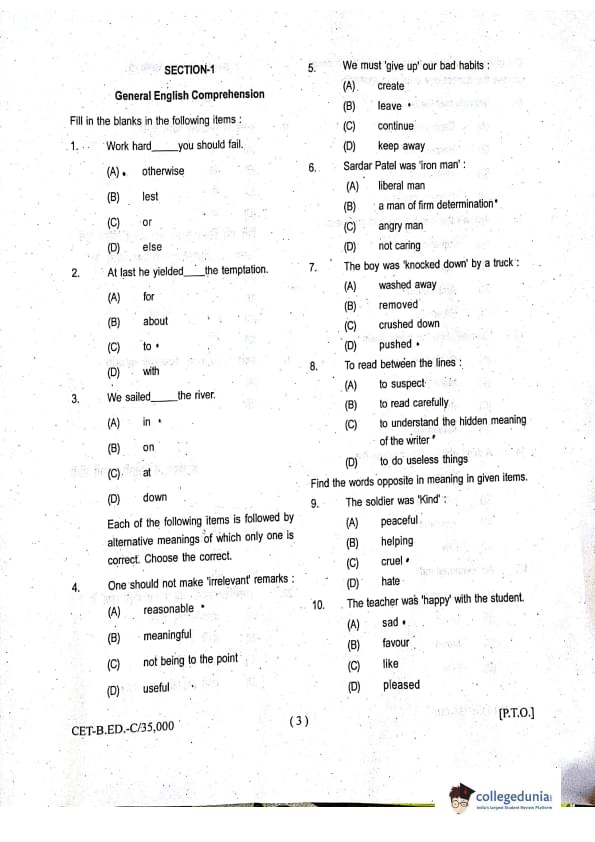




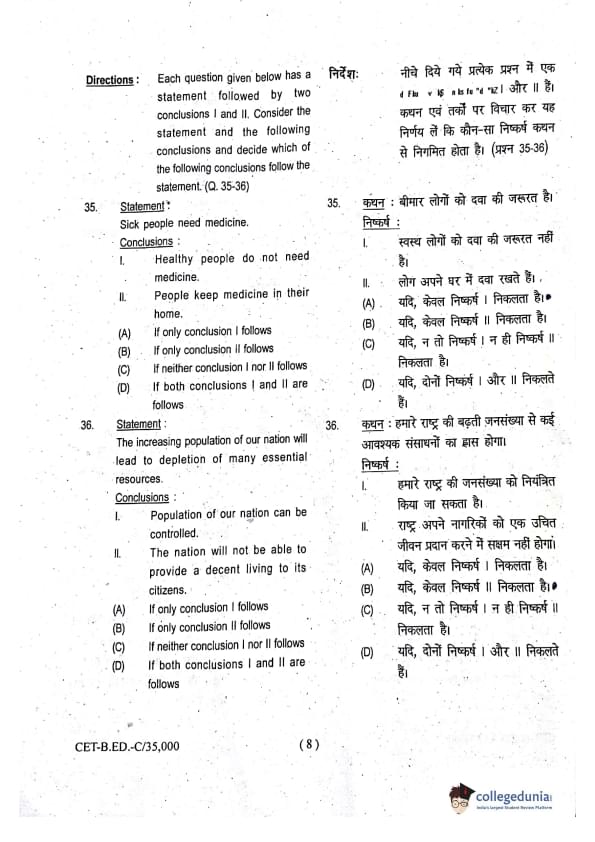
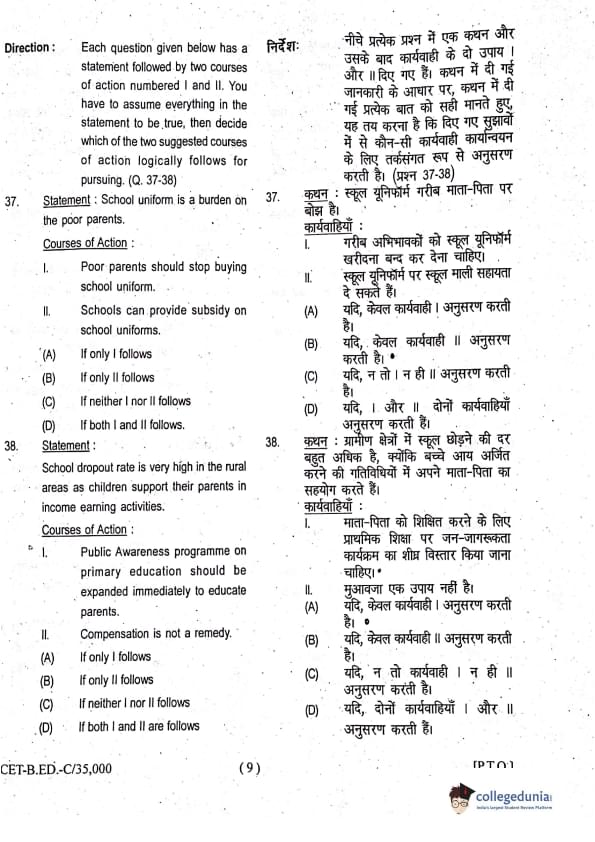
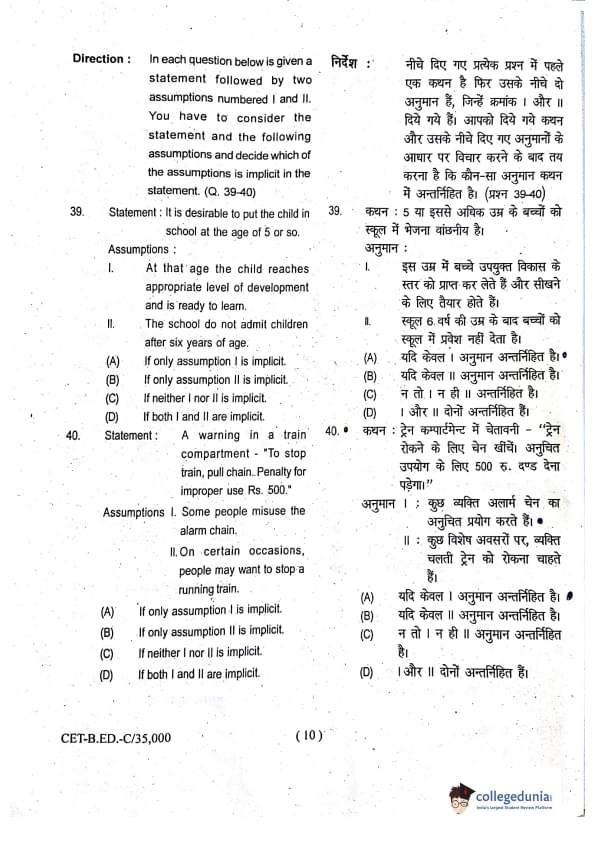
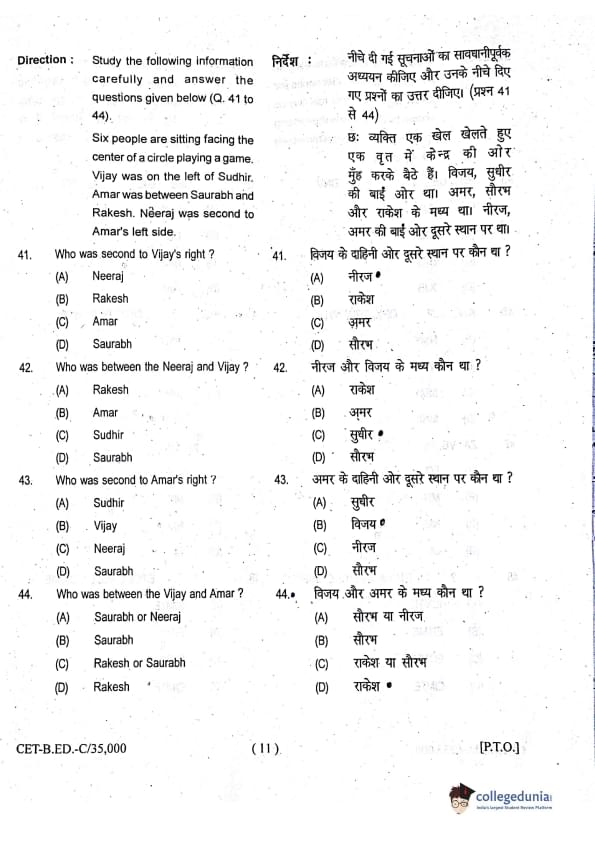

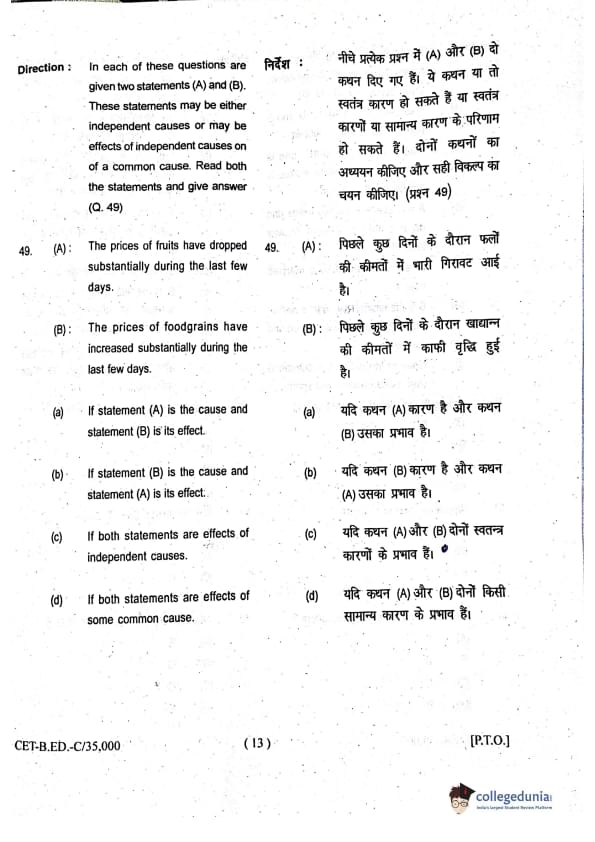


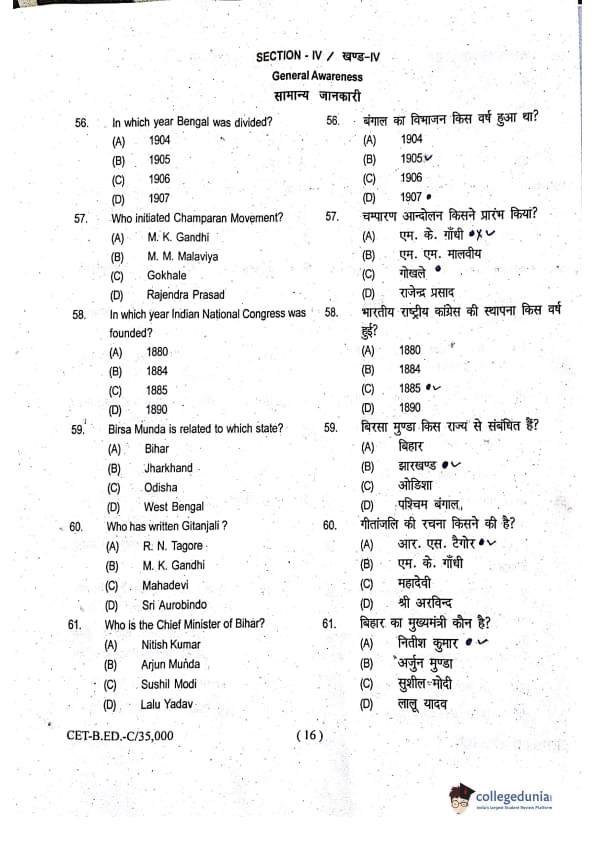

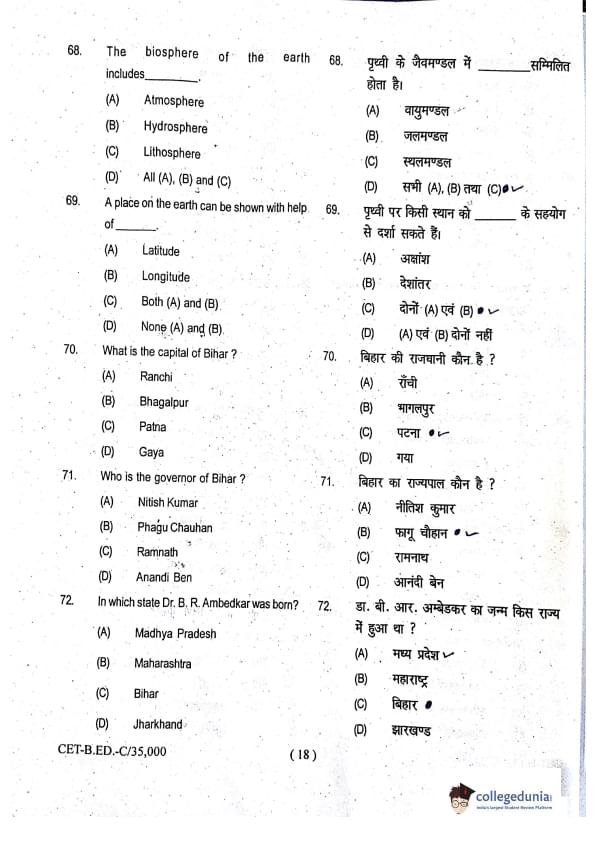
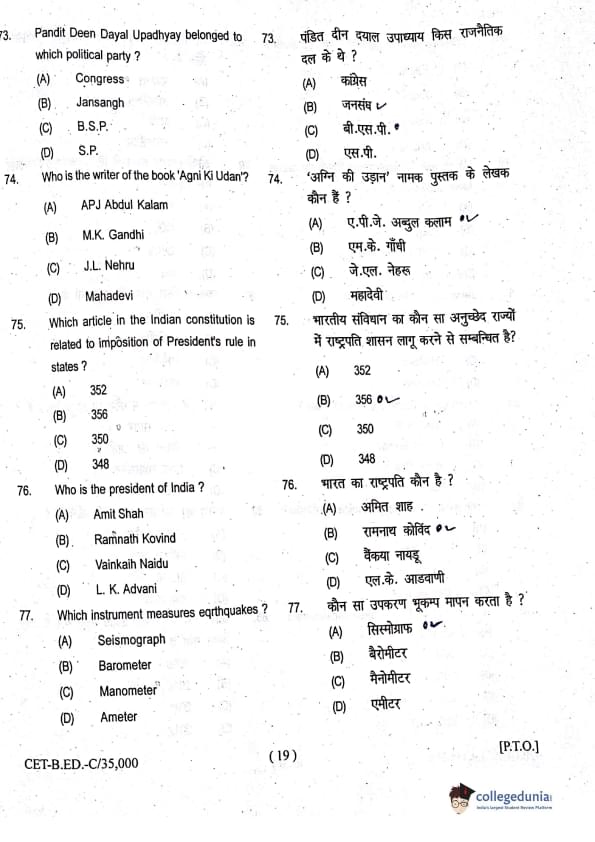
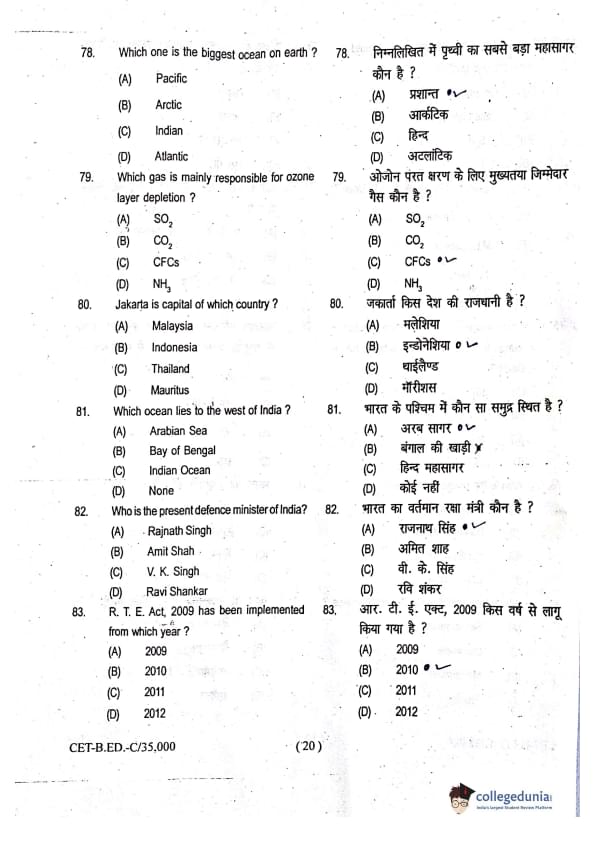

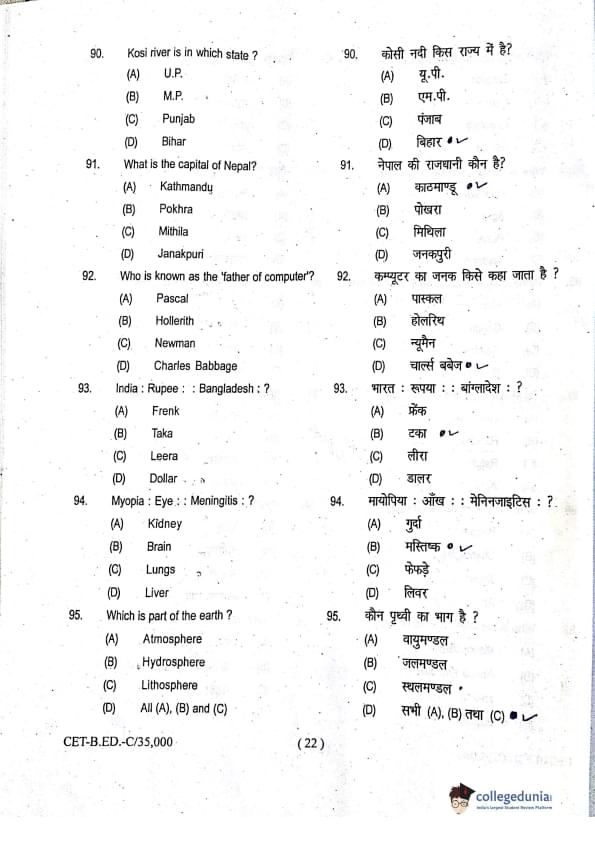
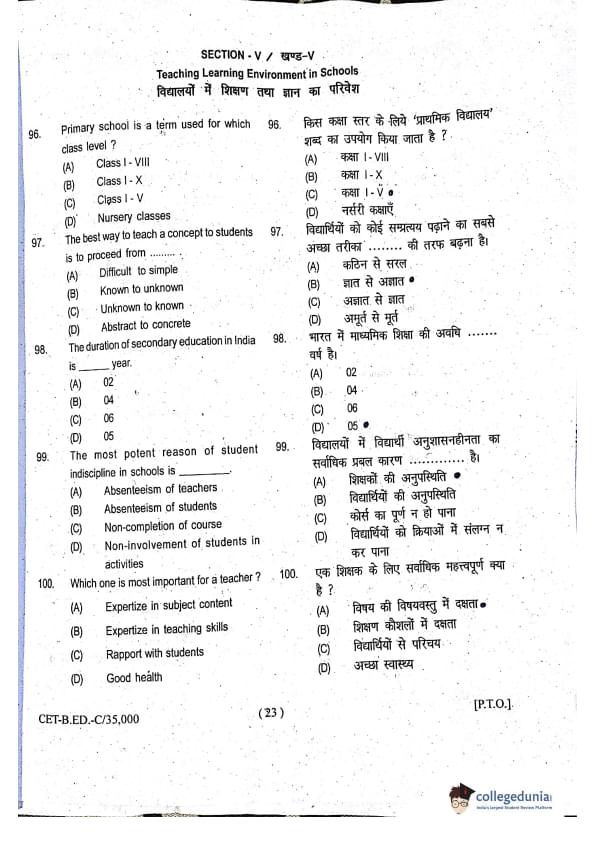
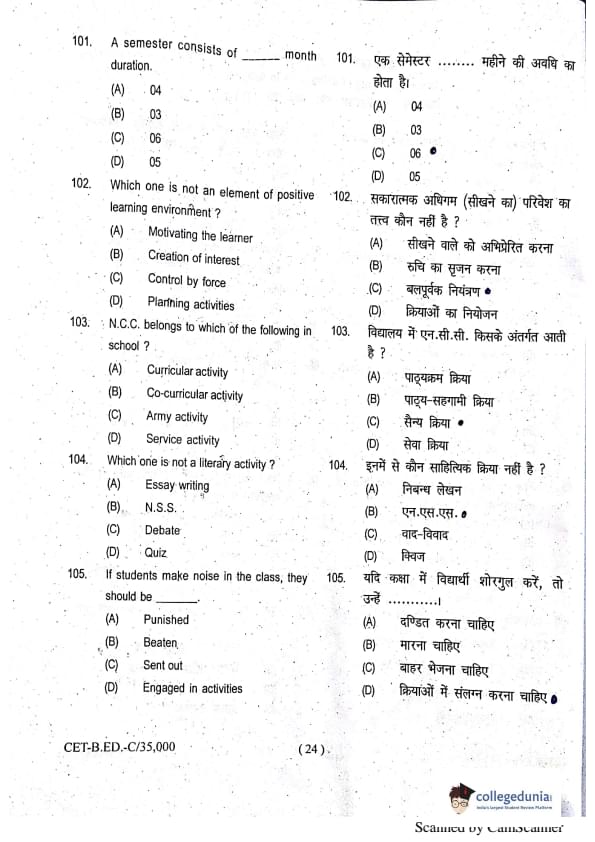
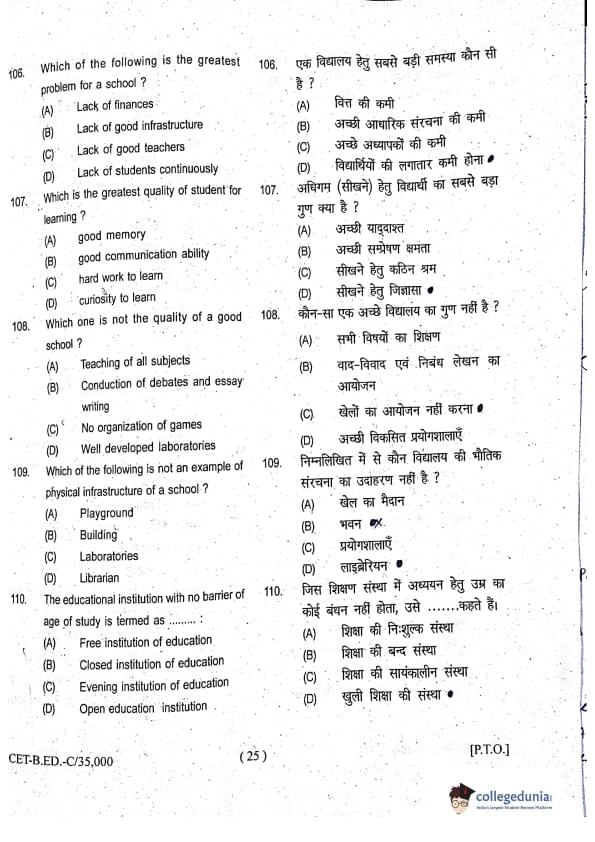
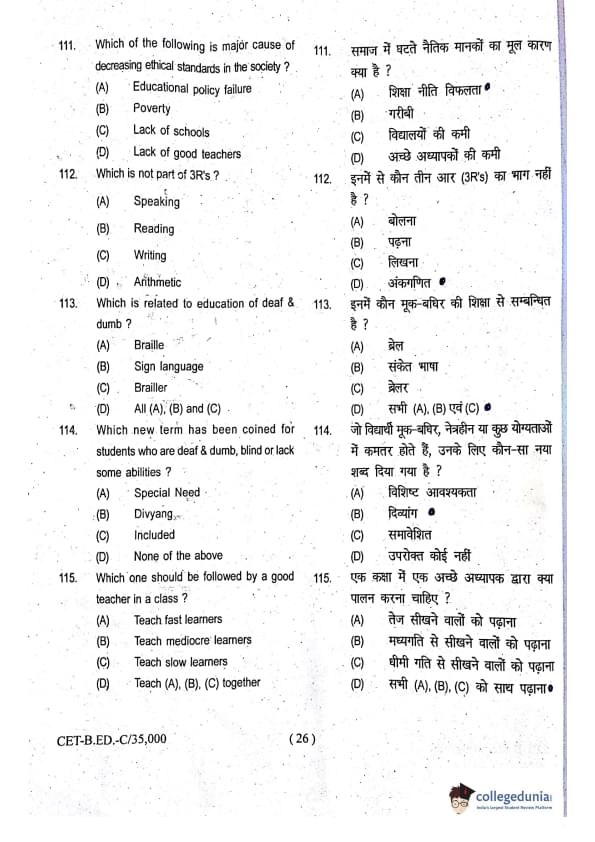
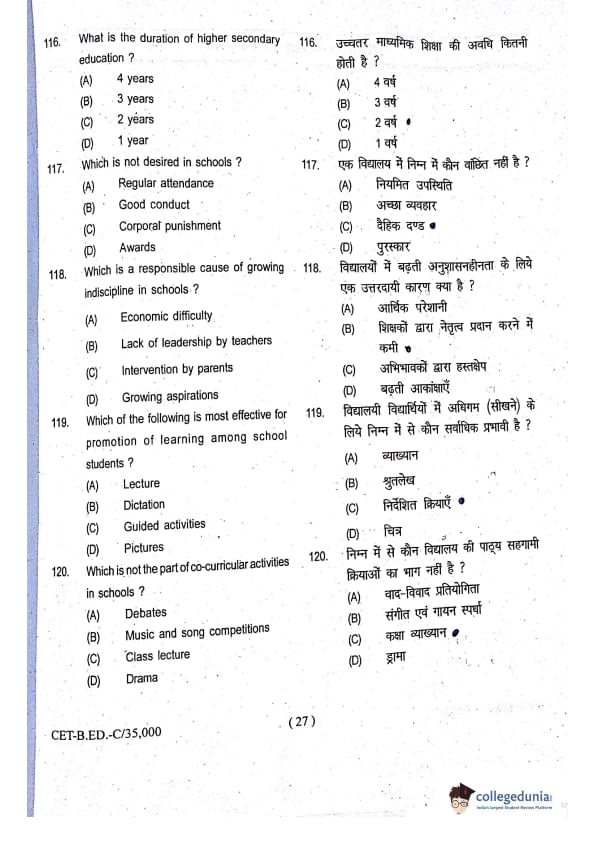
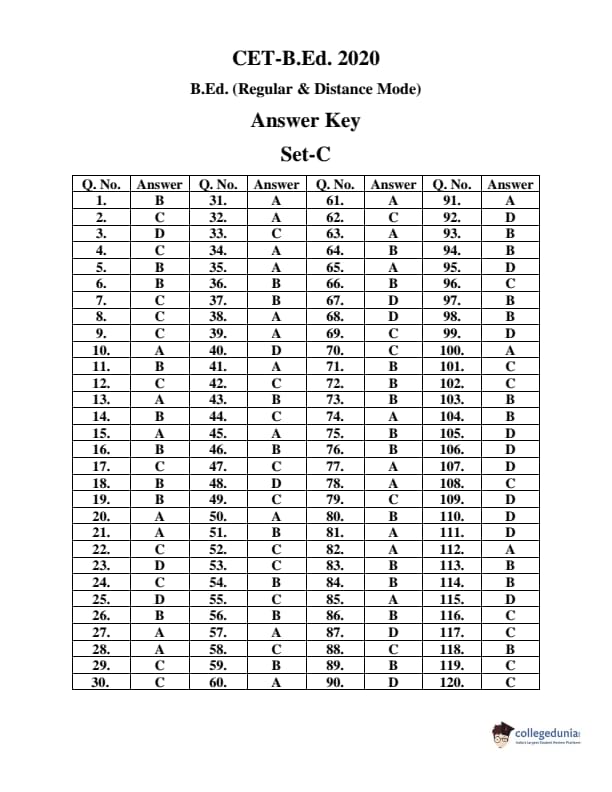



Comments